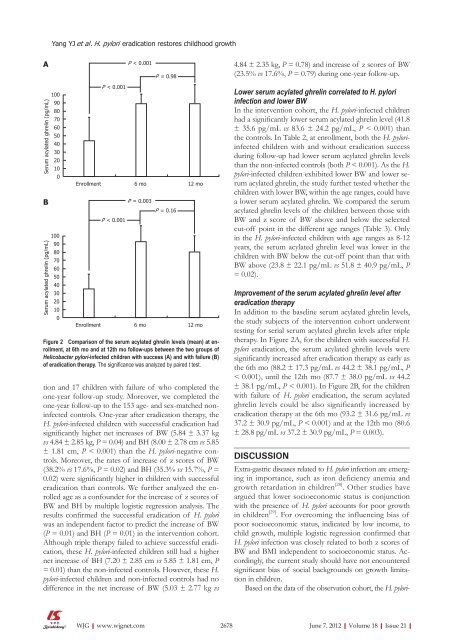Evidence base and patients' perspective - World Journal of ...
Evidence base and patients' perspective - World Journal of ...
Evidence base and patients' perspective - World Journal of ...
Create successful ePaper yourself
Turn your PDF publications into a flip-book with our unique Google optimized e-Paper software.
A<br />
Serum acylated ghrelin (pg/mL)<br />
B<br />
Serum acylated ghrelin (pg/mL)<br />
Yang YJ et al . H. pylori eradication restores childhood growth<br />
100<br />
90<br />
80<br />
70<br />
60<br />
50<br />
40<br />
30<br />
20<br />
10<br />
0<br />
100<br />
90<br />
80<br />
70<br />
60<br />
50<br />
40<br />
30<br />
20<br />
10<br />
0<br />
� < 0.001<br />
� < 0.001<br />
Figure 2 Comparison <strong>of</strong> the serum acylated ghrelin levels (mean) at enrollment,<br />
at 6th mo <strong>and</strong> at 12th mo follow-ups between the two groups <strong>of</strong><br />
Helicobacter pylori-infected children with success (A) <strong>and</strong> with failure (B)<br />
<strong>of</strong> eradication therapy. The significance was analyzed by paired t test.<br />
tion <strong>and</strong> 17 children with failure <strong>of</strong> who completed the<br />
one-year follow-up study. Moreover, we completed the<br />
one-year follow-up to the 153 age- <strong>and</strong> sex-matched noninfected<br />
controls. One-year after eradication therapy, the<br />
H. pylori-infected children with successful eradication had<br />
significantly higher net increases <strong>of</strong> BW (5.84 ± 3.37 kg<br />
vs 4.84 ± 2.85 kg, P = 0.04) <strong>and</strong> BH (8.00 ± 2.78 cm vs 5.85<br />
± 1.81 cm, P < 0.001) than the H. pylori-negative controls.<br />
Moreover, the rates <strong>of</strong> increase <strong>of</strong> z scores <strong>of</strong> BW<br />
(38.2% vs 17.6%, P = 0.02) <strong>and</strong> BH (35.3% vs 15.7%, P =<br />
0.02) were significantly higher in children with successful<br />
eradication than controls. We further analyzed the enrolled<br />
age as a confounder for the increase <strong>of</strong> z scores <strong>of</strong><br />
BW <strong>and</strong> BH by multiple logistic regression analysis. The<br />
results confirmed the successful eradication <strong>of</strong> H. pylori<br />
was an independent factor to predict the increase <strong>of</strong> BW<br />
(P = 0.01) <strong>and</strong> BH (P = 0.01) in the intervention cohort.<br />
Although triple therapy failed to achieve successful eradication,<br />
these H. pylori-infected children still had a higher<br />
net increase <strong>of</strong> BH (7.20 ± 2.85 cm vs 5.85 ± 1.81 cm, P<br />
= 0.01) than the non-infected controls. However, these H.<br />
pylori-infected children <strong>and</strong> non-infected controls had no<br />
difference in the net increase <strong>of</strong> BW (5.03 ± 2.77 kg vs<br />
WJG|www.wjgnet.com<br />
� = 0.98<br />
Enrollment 6 mo 12 mo<br />
� < 0.001<br />
� = 0.003<br />
� = 0.16<br />
Enrollment 6 mo 12 mo<br />
4.84 ± 2.35 kg, P = 0.78) <strong>and</strong> increase <strong>of</strong> z scores <strong>of</strong> BW<br />
(23.5% vs 17.6%, P = 0.79) during one-year follow-up.<br />
Lower serum acylated ghrelin correlated to H. pylori<br />
infection <strong>and</strong> lower BW<br />
In the intervention cohort, the H. pylori-infected children<br />
had a significantly lower serum acylated ghrelin level (41.8<br />
± 35.6 pg/mL vs 83.6 ± 24.2 pg/mL, P < 0.001) than<br />
the controls. In Table 2, at enrollment, both the H. pyloriinfected<br />
children with <strong>and</strong> without eradication success<br />
during follow-up had lower serum acylated ghrelin levels<br />
than the non-infected controls (both P < 0.001). As the H.<br />
pylori-infected children exhibited lower BW <strong>and</strong> lower serum<br />
acylated ghrelin, the study further tested whether the<br />
children with lower BW, within the age ranges, could have<br />
a lower serum acylated ghrelin. We compared the serum<br />
acylated ghrelin levels <strong>of</strong> the children between those with<br />
BW <strong>and</strong> z score <strong>of</strong> BW above <strong>and</strong> below the selected<br />
cut-<strong>of</strong>f point in the different age ranges (Table 3). Only<br />
in the H. pylori-infected children with age ranges as 8-12<br />
years, the serum acylated ghrelin level was lower in the<br />
children with BW below the cut-<strong>of</strong>f point than that with<br />
BW above (23.8 ± 22.1 pg/mL vs 51.8 ± 40.9 pg/mL, P<br />
= 0.02).<br />
Improvement <strong>of</strong> the serum acylated ghrelin level after<br />
eradication therapy<br />
In addition to the <strong>base</strong>line serum acylated ghrelin levels,<br />
the study subjects <strong>of</strong> the intervention cohort underwent<br />
testing for serial serum acylated ghrelin levels after triple<br />
therapy. In Figure 2A, for the children with successful H.<br />
pylori eradication, the serum acylated ghrelin levels were<br />
significantly increased after eradication therapy as early as<br />
the 6th mo (88.2 ± 17.3 pg/mL vs 44.2 ± 38.1 pg/mL, P<br />
< 0.001), until the 12th mo (87.7 ± 38.0 pg/mL vs 44.2<br />
± 38.1 pg/mL, P < 0.001). In Figure 2B, for the children<br />
with failure <strong>of</strong> H. pylori eradication, the serum acylated<br />
ghrelin levels could be also significantly increased by<br />
eradication therapy at the 6th mo (93.2 ± 31.6 pg/mL vs<br />
37.2 ± 30.9 pg/mL, P < 0.001) <strong>and</strong> at the 12th mo (80.6<br />
± 28.8 pg/mL vs 37.2 ± 30.9 pg/mL, P = 0.003).<br />
DISCUSSION<br />
Extra-gastric diseases related to H. pylori infection are emerging<br />
in importance, such as iron deficiency anemia <strong>and</strong><br />
growth retardation in children [28] . Other studies have<br />
argued that lower socioeconomic status is conjunction<br />
with the presence <strong>of</strong> H. pylori accounts for poor growth<br />
in children [29] . For overcoming the influencing bias <strong>of</strong><br />
poor socioeconomic status, indicated by low income, to<br />
child growth, multiple logistic regression confirmed that<br />
H. pylori infection was closely related to both z scores <strong>of</strong><br />
BW <strong>and</strong> BMI independent to socioeconomic status. Accordingly,<br />
the current study should have not encountered<br />
significant bias <strong>of</strong> social backgrounds on growth limitation<br />
in children.<br />
Based on the data <strong>of</strong> the observation cohort, the H. pylori-<br />
2678 June 7, 2012|Volume 18|Issue 21|

















